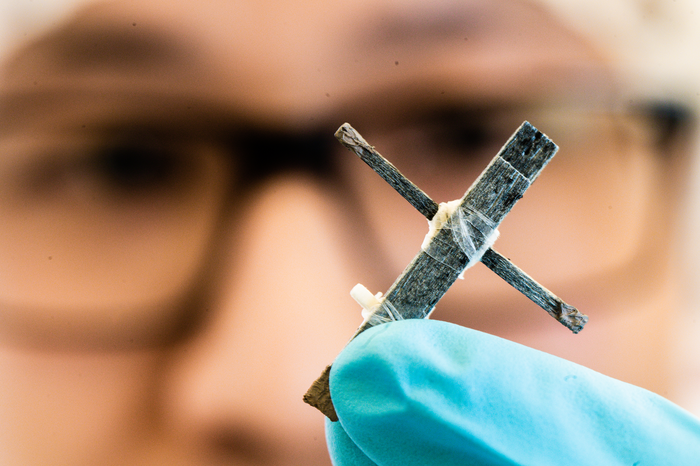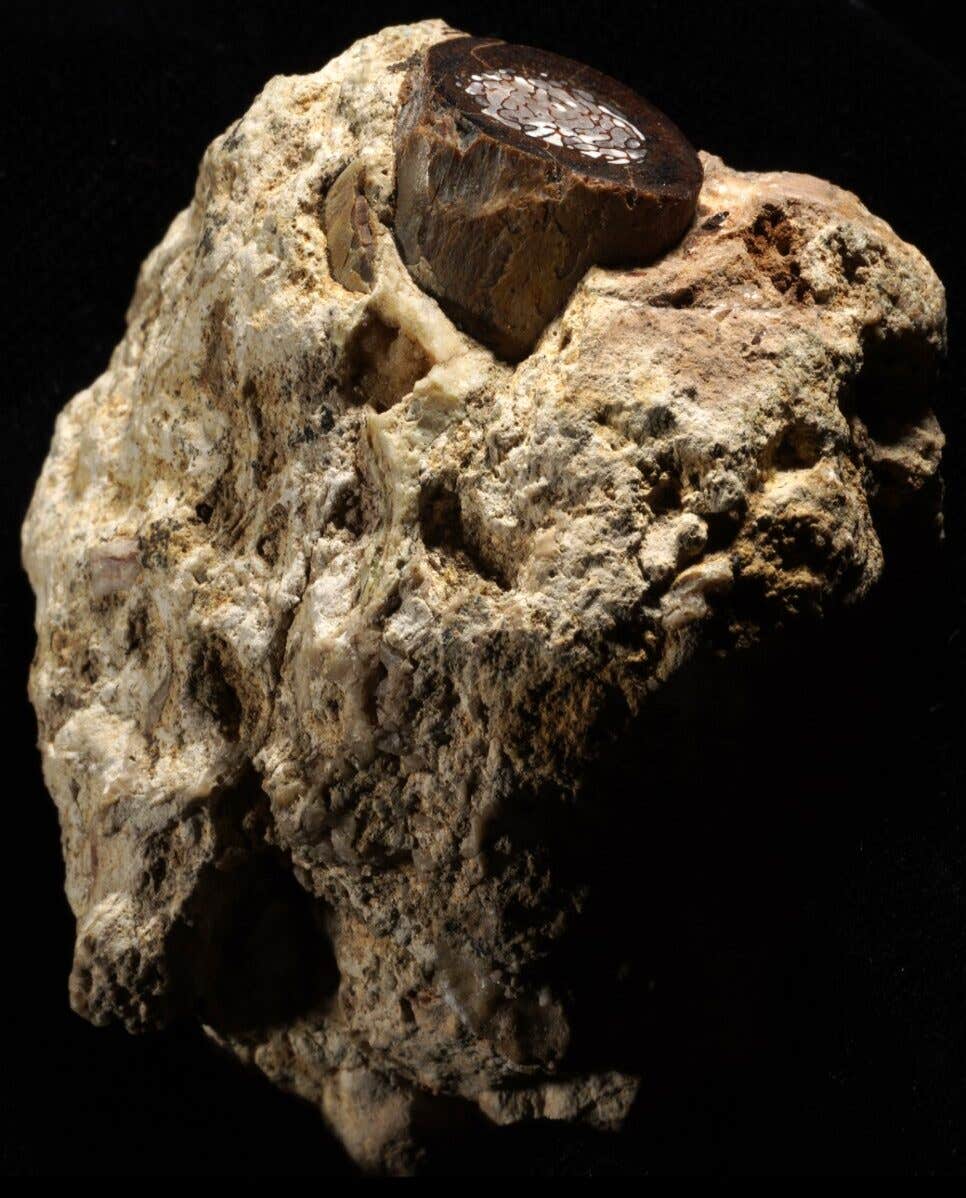Green Energy: Scientists develop the world’s first wood transistor
New development could potentially lead to further advancements in wood-based electronics and also help with controlling electronic plants.

[Apr. 28, 2023: Staff Writer, The Brighter Side of News]
Researchers at Linköping University, together with colleagues from the KTH Royal Institute of Technology, have now developed the world’s first electrical transistor made of wood. (CREDIT: Thor Balkhed)
Swedish scientists from Linköping University and the KTH Royal Institute of Technology have recently made a breakthrough in the field of electronics by creating the world’s first-ever transistor made of wood.
This new development could potentially lead to further advancements in wood-based electronics and also help with controlling electronic plants. The study has been published in the scientific journal Proceedings of the National Academy of Sciences (PNAS).
Transistors are a crucial component in modern electronic devices and have been around for almost a century. They regulate the current passing through them and can also act as a power switch. With the latest development, researchers at the Laboratory for Organic Electronics at Linköping University, in collaboration with colleagues from KTH Royal Institute of Technology, have created a functioning electrical transistor using wood. Although it is slow and bulky, it has enormous potential for further development.
Isak Engquist, senior associate professor at the Laboratory for Organic Electronics at Linköping University, said, “We’ve come up with an unprecedented principle. Yes, the wood transistor is slow and bulky, but it does work and has huge development potential.”
Related Stories
In previous trials, transistors made of wood could only regulate ion transport, which stops functioning once the ions run out. However, the transistor created by the Linköping researchers can regulate electricity flow continuously without deteriorating.
The scientists used balsa wood to create their transistor, which requires a grainless wood that has an even structure throughout. They removed the lignin, leaving only long cellulose fibres with channels where the lignin had been. These channels were then filled with a conductive plastic, or polymer, called PEDOT:PSS, creating an electrically conductive wood material.
The researchers used this new material to create a functioning transistor that could regulate electric current and provide continuous function at a selected output level. It could also switch power on and off, although with a certain delay – turning it off took about a second, and on, about five seconds.
Isak Engquist, senior associate professor at the Laboratory for Organic Electronics at Linköping University. (CREDIT: Thor Balkhed)
The new development of wood-based electronics could have several potential applications, such as regulating electronic plants, which is another strong research area at Linköping University. One advantage of the transistor channel being so large is that it could potentially tolerate a higher current than regular organic transistors, which could be essential for certain future applications.
Isak Engquist emphasises that this development was not created with a particular application in mind but rather as a result of basic research. “We didn’t create the wood transistor with any specific application in mind. We did it because we could. This is basic research, showing that it’s possible, and we hope it will inspire further research that can lead to applications in the future,” he said.
The study was financially supported by the Knut and Alice Wallenberg Foundation through the Wallenberg Wood Science Center. The research team hopes that this new development will encourage further research, which could lead to new applications in the future.
Isak Engquist, senior associate professor, and Van Chinh Tran, PhD student at Linköping University. (CREDIT: Thor Balkhed)
According to Magnus Berggren, a professor of organic electronics at Linköping University and one of the authors of the study, the new development is just the beginning, and the team will continue to explore the potential of wood-based electronics.
“This study shows that it is possible to use nature’s own materials to create advanced technology, which can open up new possibilities for the future,” he said. “We are still in the early stages of this research, and there is still much to discover.”
The use of wood in electronics may sound surprising, but researchers have been exploring the use of natural materials for electronic devices for some time now. In recent years, scientists have been exploring the use of materials such as silk, spider webs, and DNA to create electronic components. These materials have unique properties that could be harnessed to create new types of devices.
The schematic diagrams of (A) conductive wood preparation and (B) the wood electrochemical transistor fabrication processes. (C) From Left to Right: Front view photograph of a WECT, front view of the WECT configuration, and section of a wood fiber (conceptual view of transistor’s channel zoom-in) showing PEDOT:PSS-coated cell wall and electrolyte-transporting lumen. (CREDIT: PNAS)
The development of wood-based electronics could have several potential benefits, including reduced environmental impact and increased sustainability. Unlike traditional electronic components that are made from non-renewable resources and can take hundreds of years to degrade, wood is a renewable resource and can be sustainably sourced. In addition, wood-based electronics could potentially be biodegradable, further reducing their environmental impact.
The researchers behind the wood transistor are excited about the potential for wood-based electronics to revolutionize the field of electronics. "We believe that wood-based electronics could open up a whole new field of research and development," says Lars Berglund, professor at the Wallenberg Wood Science Center at KTH Royal Institute of Technology.
The conductivity of CW samples fabricated using different delignification times (Inset: four-point probe measurement setup).. (CREDIT: PNAS)
One potential application for wood-based electronics is in electronic plants. Electronic plants are plants that have been genetically engineered to produce an electrical signal when exposed to certain stimuli, such as changes in light or temperature. These electrical signals can be used to detect environmental changes, such as the presence of pollutants or the onset of drought.
Electronic plants are still in the experimental phase, but they have the potential to revolutionize the way we monitor and understand the environment. However, the development of electronic plants requires the use of specialized electronic components that are biocompatible and can be integrated with living plant tissue. Traditional electronic components are not suitable for this purpose, as they can be toxic to plants and do not have the necessary properties to interact with living tissue.
Wood-based electronics, on the other hand, could be ideal for use in electronic plants. Wood is a natural material that is biocompatible and can be integrated with living tissue. The wood transistor developed by the researchers at Linköping University and KTH Royal Institute of Technology could be a key component in the development of electronic plants.
In addition to electronic plants, wood-based electronics could have applications in other fields as well. For example, wood-based sensors could be used to monitor the structural health of buildings and bridges. Wood-based electronics could also be used in wearable devices and other applications where biocompatibility and sustainability are important considerations.
However, there are still many challenges that need to be overcome before wood-based electronics can become a mainstream technology. One of the biggest challenges is improving the performance of wood-based electronic components. While the wood transistor developed by the researchers at Linköping University and KTH Royal Institute of Technology is a promising first step, it is still slower and bulkier than traditional electronic components.
Another challenge is scaling up production of wood-based electronics. Currently, the process of creating wood-based electronic components is time-consuming and requires specialized equipment. Developing more efficient and scalable manufacturing processes will be crucial to the commercialization of wood-based electronics.
Despite these challenges, the development of the world's first wood transistor is an exciting milestone in the field of electronics. It demonstrates that there is potential for sustainable and biocompatible electronic components that can be integrated with living tissue. With further research and development, wood-based electronics could revolutionize the way we interact with the environment and with each other.
For more science and technology news stories check out our New Innovations section at The Brighter Side of News.
Note: Materials provided above by The Brighter Side of News. Content may be edited for style and length.
Like these kind of feel good stories? Get the Brighter Side of News' newsletter.



